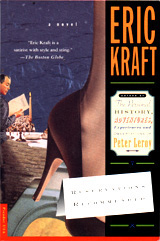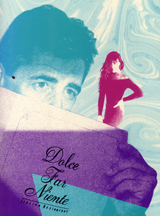
YOU CAN READ
|
Dining is like going to the theater. Cooking for the public is like acting. The show must go on. If the chef’s mother dies, we should not taste tears in the béarnaise.BW endorses this attitude without reservations. Matthew isn’t so sure. The Alley View is crowded when Matthew and Belinda arrive—jammed, in fact. This is often a bad sign, since it may mean a deliberate appeal to mass taste or current fashion, or as BW once wrote, “far worse, it may mean an unthinking appeal to mass taste or current fashion.” They are greeted by a man who would make a good wrestler. He’s bulging out of an expensive double-breasted suit, a silk-and-wool blend. From dark roots, blond hair cascades in ringlets to his shoulders. He’s holding a huge pair of chrome-plated pliers with blue rubber grips. He gives Matthew and Belinda a big smile, displaying dozens of paper-white teeth. Matthew takes an immediate dislike to him. “Here for an extraction?” the wrestler asks. That can’t be what he asks. He must be asking whether Matthew has a reservation. “Barber,” Matthew says. “Uh-uh,” says the wrestler, shaking his head. Another big smile. “Guess again.” Maybe we should leave, thinks Matthew. This might be leading to some kind of serious trouble. He has learned that one never knows when one is going to run into a psychotic and rub him the wrong way with an innocent remark. An apparently simple-minded, baffled smile seems the safest response, certainly safer than words. You just can’t tell about words. The remark you make may turn out to have been the psychotic’s mother’s last words or some other hair-trigger tripper. Matthew smiles a simpleminded, baffled smile. “Dentist!” the wrestler says, raising the pliers in front of Matthew’s face. “Oh, is that what you said? ‘Extraction.’ I thought that was what you said, but it didn’t seem likely, so I thought you must have asked if I had a reservation. Extraction. Sure. No, I mean. No thanks. I do have a reservation, though. Barber. The name is Barber.” He feels like an idiot. “Barber. Mister Barber. We’ll have a table for you in just a few minutes. Would you like to have a drink while you wait?” They would, so they go to the bar. The crowd is lively, almost entirely composed of people younger than they. Matthew tries out, mentally, a string of adjectives that BW could use to describe them in the review. He comes up with attractive, well dressed, talkative, ebullient, vapid. The last isn’t a fair assessment. These people are upsetting him because they’re young, attractive, well dressed, talkative, ebullient. Most of them seem to know one another; Matthew feels that he’s an outsider, that he and Belinda have been given the once-over, fairly discreetly he has to admit, identified as outsiders, dismissed as uninteresting, and are being tolerated, though they aren’t really welcome, as if they were trying to elbow their way in, taking up space that would be better occupied by someone more attractive, better-dressed, more talkative and ebullient. Matthew elbows his way to the bar. Over the bar a neon sign spells “Champagne” in green script, a prompt for neophyte drinkers. Work on that idea, Matthew tells himself. BW can use that. He orders a couple of Bombay martinis. The bartender takes the glasses and the Bombay from a freezer under the bar and pours the gin directly into the glasses. At no time does Matthew see vermouth. He doesn’t mind this, really—he likes a frozen Bombay now and then—but this glass of gelid gin is not a martini; it’s a joke at the expense of the martini, a sarcastic remark about the martini. Matthew takes it personally. WHEN HE WAS YOUNG, Matthew developed an affection for the martini well before he ever drank one, an affection that came in part from watching William Powell and Myrna Loy down them in the Thin Man movies and in part from his careful study of Esquire, the text from which he hoped to learn sophistication. The martini seemed to be an essential item among the equipment of a sophisticated adult. When Matthew began drinking them, at Harvard, he was still only an aspirant to adulthood, and by the time he had actually attained adulthood the martini had become something of an anachronism. For quite a while the young didn’t drink them, didn’t even aspire to drink them, as, perhaps, they no longer aspired to sophistication or adulthood. Matthew began to wonder whether, if the martini was an anachronism, sophistication was also an anachronism, adulthood wasn’t, too, and Matthew as well. Now, however, according to what Matthew reads in newspapers and magazines, the martini is making a comeback, and the testimony of his own eyes tells him that it’s true, but his ears tell him that the martini revival is something of a joke. People always seem to be ordering gag martinis, with a jalapeño pepper or a cornichon instead of an olive or a twist of lemon, and when he orders a martini with “an olive” he usually gets three, but at least he no longer feels as conspicuous ordering one. He wouldn’t feel conspicuous at all if he didn’t think that his graying hair marks him as a member of an earlier generation of martini drinkers, a humorless bunch. |
 |
||
|
RESERVATIONS
RECOMMENDED | CHAPTER 1, PART 4 | CONTENTS
PAGE
|

 Here
are a couple of swell ideas from Eric Kraft's vivacious publicist, Candi
Lee Manning:
Here
are a couple of swell ideas from Eric Kraft's vivacious publicist, Candi
Lee Manning:
